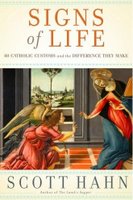There are years when it’s a delight to turn the calendar pages, and this is one of them.
I realize that not every place on the map experienced the epic storms we had in eastern Ohio, but many odd corners got at least a dusting of snow. It fell in forty-nine out of fifty United States, and it actually accumulated beneath the pope’s balcony, in St. Peter’s Square.
My university colleagues and I found ourselves with a record number of canceled classes. My colleagues on the speaker circuit found themselves pacing the corridors of distant airports, glancing nervously at flight monitors along the way.
As I said, it’s a delight to turn the page on my wall calendar. As we shift from March to April, winter to spring, sweaters to shirt sleeves, we’re shifting from Lent to Easter—from dying to the first signs of new life.

In my book Signs of Life (Doubleday), I talk a bit about how the calendar works for God’s people. Rabbi Samson Raphael Hirsch, the founder of modern Orthodox Judaism, said: “The catechism of the Jew consists of his calendar.” And that’s true, too, of the Christian year. Though we Catholics do have a catechism (and thank God for that!), we often learn our doctrine much more deeply simply by celebrating the feasts and fasts of the Church. In fact, the Catechism speaks of the calendar as a yearlong teaching moment. “The cycle of the liturgical year and its great feasts are … basic rhythms of the Christian’s life of prayer” (CCC, n. 2698). The great feasts “commemorate” and “communicate” the mystery of Christ (n. 1171). They are an invitation to regular prayer, intended to nourish continual prayer (n. 2720, 2698).
“Counting the days” is an integral part of what we do and who we are. It’s human nature. We mark anniversaries and birthdays. We celebrate milestones. We define ourselves by those dates and spans—how long we’ve been married, how long we’ve been Catholic, how long we’ve been parents or grandparents, how long we’ve worked in this place. It’s our nature to mark time this way, to number our days aright.
No one knows human nature better than the God who created it. That’s why he fashioned the world to follow certain rhythms. The Book of Genesis tells us that the Lord God made the world in six days and rested on the seventh. The sacred calendar coincided with the cosmic rhythms, and the cosmic rhythms themselves were put in place to provide a haven for holiness.

When the Word became flesh, all creation and all history found fulfillment. Thus, all of human time coalesced around the Resurrection of Jesus. The week no longer led to Sabbath, but to Sunday, the day on which Jesus rose from the dead. The year still culminated in the Passover, but now the Christian Passover, which is the feast and the season of Easter.
Our calendar brings times of fasting and time of feasting, times of sorrow and times of joy, times of penance and times of reconciliation. All creation tells the story. All history tells the story. All our lives, yours and mine, tell the story.
It is a story of hope. My hope is that you feel the fullness of the year overflow in your heart this season, and in the hearts of your loved ones this year. More than my hope, it is my prayer.
I ask your prayers for us at the St. Paul Center. We have been liberated from the winter storms, but we still face a difficult economy for fundraising—and so for functioning in our apostolic work. You have been very generous to us, and for that I thank you. You remain close to all of us, especially now as we turn the page, from season to season, to new life.


